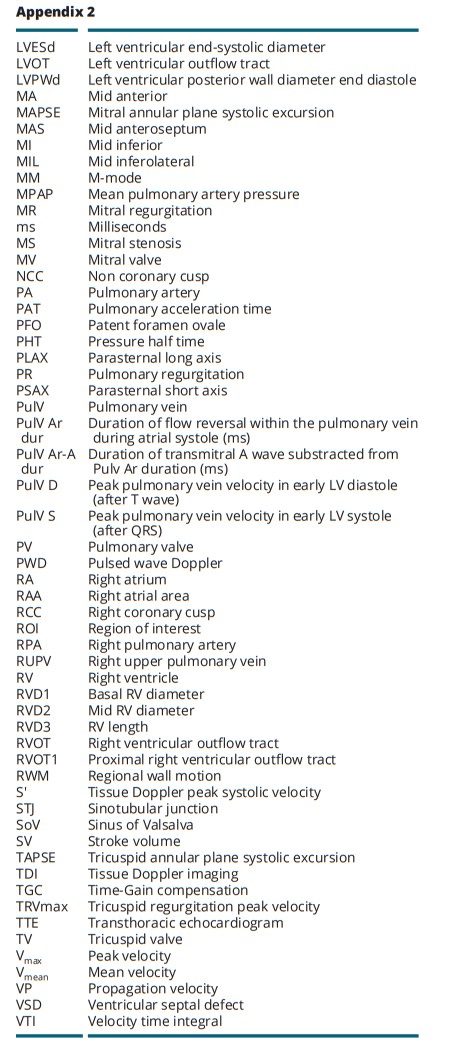In this post I link to and excerpt from A practical guideline for performing a comprehensive transthoracic echocardiogram in adults: the British Society of Echocardiography minimum dataset [PubMed Abstract] [Full-Text HTML] [Full-Text PDF]. Echo Res Pract. 2020 Dec; 7(4): G59–G93. Published online 2020 Oct 20. doi: 10.1530/ERP-20-0026.
Table 1 demonstrates all the views to be obtained. It is from p 8 to p 31 of the 35-page PDF. There are approximately 85 images with clear brief explanations of the meanings of each image. These images provide an excellent rapid and complete review.
All that follows is from the above resource.
Abstract
Since cardiac ultrasound was introduced into medical practice around the middle twentieth century, transthoracic echocardiography has developed to become a highly sophisticated and widely performed cardiac imaging modality in the diagnosis of heart disease. This evolution from an emerging technique with limited application, into a complex modality capable of detailed cardiac assessment has been driven by technological innovations that have both refined ‘standard’ 2D and Doppler imaging and led to the development of new diagnostic techniques. Accordingly, the adult transthoracic echocardiogram has evolved to become a comprehensive assessment of complex cardiac anatomy, function and haemodynamics. This guideline protocol from the British Society of Echocardiography aims to outline the minimum dataset required to confirm normal cardiac structure and function when performing a comprehensive standard adult echocardiogram and is structured according to the recommended sequence of acquisition. It is recommended that this structured approach to image acquisition and measurement protocol forms the basis of every standard adult transthoracic echocardiogram. However, when pathology is detected and further analysis becomes necessary, views and measurements in addition to the minimum dataset are required and should be taken with reference to the appropriate British Society of Echocardiography imaging protocol*. [Emphasis Addeded] It is anticipated that the recommendations made within this guideline will help standardise the local, regional and national practice of echocardiography, in addition to minimising the inter and intra-observer variation associated with echocardiographic measurement and interpretation.
Keywords: transthoracic echocardiography, echocardiography, minimum dataset
*Protocols and guidelines [from The British Society of Echocardiography]
- Mitral valve
- Aortic stenosis
- Tri-cuspid and pulmonary valves
- Cardio-oncology
- Normal reference intervals
- Right heart assessment
- Replacement heart valves
- Comprehensive transthoracic echocardiogram: Minimum dataset
- Standard transoesophageal echocardiogram
- Hypertrophic cardiomyopathy
- TOE safety checklist
- Pulmonary hypertension
- Indications for echocardiography (PDF)
- Diastolic function – under construction!
- Mitral stenosis (PDF)
- Mitral valve repair (PDF)
- Assessment of aortic regurgitation (PDF)
- ARVC (PDF)
- Marfans syndrome (PDF)
- TOE decontamination (PDF)
- Safe sedation (PDF)
- Sports screening (PDF)
- Restrictive cardiomyopathy (PDF)
- Chaperones and echocardiography (PDF)
Study duration
Since the BSE first published a protocol identifying a
minimum dataset for performing standard TTE, the
complexity and number of measures made during
a standard echocardiogram has grown consistently
with each iteration. It has been suggested in previous
versions of the minimum dataset guideline that the
average time required for the performance and reporting
a comprehensive transthoracic echocardiogram is
considered to be 40–45 min (25). Although it is feasible for
the comprehensive minimum dataset to be acquired and
reported within 45 min in a subject with normal cardiac
anatomy and function, it must be recognised that the vast
majority of patients undergoing a standard TTE in clinical
practice require further analysis of cardiac pathology. As
such, further time may need to be given in assessment of
complex and multiple pathologies or when time is needed
for advanced post-processing such as 3D volumes or GLS.
In these scenarios, the overall time to acquire and report
my take an extra 5–10 min.
Table 1 demonstrates all the views to be obtained. It is from p.8 – p.31 of the 35-page PDF. It is an excellent rapid and complete review.







